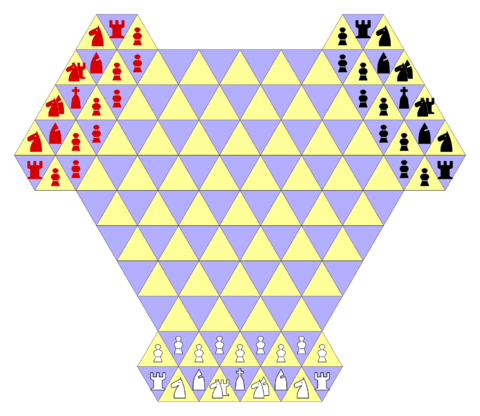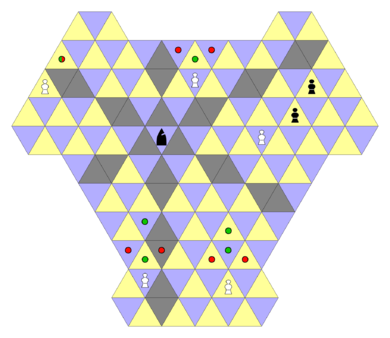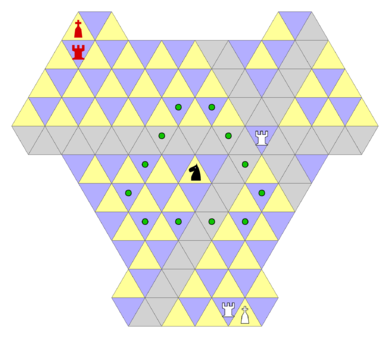
- Chess World Cup
- FIDE Grand Prix
- Olympiad
- World Championship
- List of strong tournaments
- List of world championships

- Checkmate patterns
- Chess openings
- Chess strategy
- Chess tactics
- Chess theory
- Endgames
- Pawn structure
- Problems/Compositions












 Tri-Chess gameboard and starting position. In the diagram, chancellors are represented by rook and knight combined; cardinals are represented by bishop and knight combined.
Tri-Chess gameboard and starting position. In the diagram, chancellors are represented by rook and knight combined; cardinals are represented by bishop and knight combined.Tri-Chess is the name of a chess variant for three players invented by George R. Dekle, Sr. in 1986. The game is played on a board comprising 150 triangular cells. The standard chess pieces are present, minus the queens, and plus the chancellor and cardinal compound fairy pieces per side.
Tri-Chess was included in World Game Review No. 10 edited by Michael Keller.
The illustration shows the starting setup. White moves first and play proceeds clockwise around the board. When a player is checkmated or stalemated, his king is immediately removed from the game and his remaining men become the property of the player delivering the mate or stalemate. Pawns of appropriated armies do not change their direction of movement toward promotion. The last surviving player wins the game.
 The bishop moves along cells in the diagram colored dark gray. The white pawns can move to cells marked with green dots, or capture on red dots. White promotes on any cell on the 10th rank of the board. In the diagram, White's pawn on the 7th rank blocks Black's pawn on the 8th from moving forward. If the black pawn on White's 9th rank advances, the white pawn can capture it, for example: by e.p.
The bishop moves along cells in the diagram colored dark gray. The white pawns can move to cells marked with green dots, or capture on red dots. White promotes on any cell on the 10th rank of the board. In the diagram, White's pawn on the 7th rank blocks Black's pawn on the 8th from moving forward. If the black pawn on White's 9th rank advances, the white pawn can capture it, for example: by e.p.
 The rook moves along cells in the diagram colored light gray. The knight can move to green dots. Red has castled "chancellor-side"; White has castled "cardinal-side".
The rook moves along cells in the diagram colored light gray. The knight can move to green dots. Red has castled "chancellor-side"; White has castled "cardinal-side".